Stretching out over 600 feet, the front façade of Aldo Rossi’s Gallaratese housing block stands as a challenge to all the apartment buildings around it: do it, do it simply, do it plain, stop. Half a century since it was constructed, this four-story row of modest dwelling units still represents the essence of multifamily living. That is not to say that it is the best and the most sophisticated—let alone the most comfortable or most community-friendly—structure of its kind. It is just simply a condensation of the type.
I remember when I first saw slides of the building in Vincent Scully’s architecture lectures in 1975, the year after that Yale architectural historian had first seen it. I do not have any idea what he said, but the image of the row of square windows puncturing a white stucco façade balancing on fins, rather than columns and split down the middle to allow for the site’s slope, stuck with me. For years, I have been trying to visit the actual building, which is located in a nondescript neighborhood on Milan’s western edge, and finally (thank you, Hubert Klumpner, for the taxi ride) I was able to make my pilgrimage. It is, like almost all buildings and movie stars when you see them in real life, smaller than it looks in pictures, but just as charismatic as it must have been when it converted Scully into a fan not only of Aldo Rossi, but of his whole neo-rationalist project.
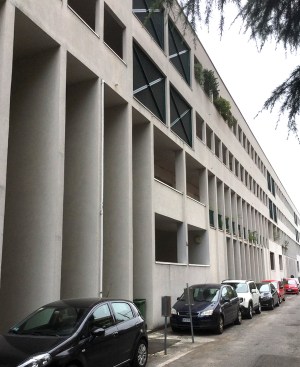
Aaron Betsky
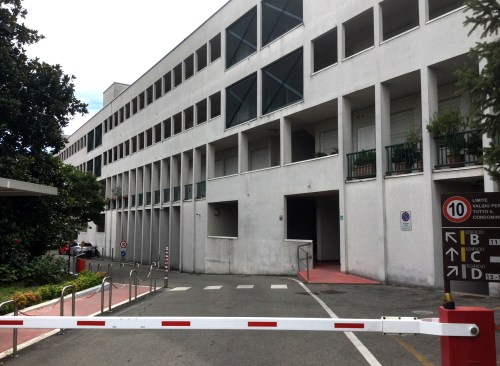
Aaron Betsky
The building is actually part of a much larger complex, most of which was designed by Rossi’s older friend Carlo Aymonino. Commissioned by a private housing developer and built in Milan’s push to alleviate the post-World War II housing shortage, it was designed in 1967 and opened in the early 1970s. Almost as soon as it was finished, however, it was the target of protests by left wing groups because of the cost of the apartments. It was taken over during one of those protests, and the city used it for a while to house homeless people. Now it seems to have fulfilled its (lower-) middle-class destiny, sitting next to a public park, its own ranges of diagonally placed blocks and shared open space protected by fences and guards whom we had to beg to let us in.
Though it is much simpler than Aymonino’s structures, which are a push and pull of stairs and balconies and terra-cotta in color, Rossi’s bar is much more complex than a first glance might lead you to expect. It is also difficult to see, standing at an angle to the street and obscured by plantings.
Rossi’s design is actually two buildings, one almost double the length of the other, separated by a narrow slot. You enter them from the back, where four stories of access galleries stretch out the length of the two buildings above a partially permeable base. The galleries open to the outside behind rows of square openings. At five points, open-air staircases make themselves known with larger openings and, above them and off-centered, square windows at a much larger scale, screened and marked with an X, punctuate the composition. On the ground floor, the longer building opens with two-story fins, past which you enter into the ground-floor colonnade, while the shorter one has a more irregular pattern of openings.
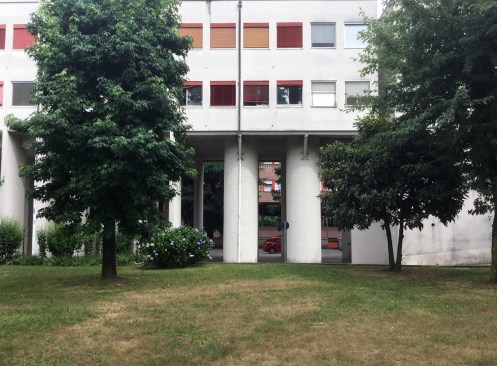
Aaron Betsky
The garden façade is simpler, with the two upper floors of apartments continuing without variation the length of both buildings. In the longer structure, the colonnade steps up to be two stories tall, while the shorter building has an extra floor of housing as the ground drops away below it. The end closest to its counterpart is marked by two larger columns. The details are even more stripped-down. The windows have minimal frames or, in the case of the porches that Rossi treated like just more rooms, none at all. The fins have only a slight setback in the façade to act as a reverse lintel. All of this contributes to making a building that swoops past you without any apparent interest in showing you what is inside, how it was made, or how you even enter it, even more enigmatic, as all the clues that might offer suggestions for such facts are out of scale, in the wrong place, or odd in their scale.
Those fins acting in the place of columns are the most extreme examples of that deformation of common forms and practices. They are thin, tall, and tightly spaced. While they refer to columns and act as such, they also continue the façade, are too close together to be logical, and have none of the accoutrements of the classical traditions out of which such elements came. They create a rhythm on the outside and the inside of the building, but they also offer a border that is both overstated and ambiguous. Moreover, nothing is meant to happen in this space—it is just 600 feet of shaded emptiness, with a few bicycles tucked in discreetly into the corners.
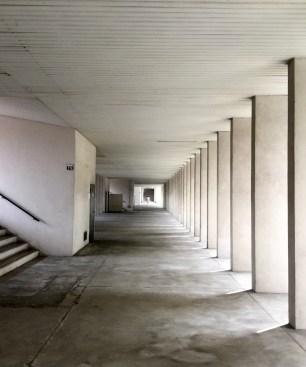
Aaron Betsky
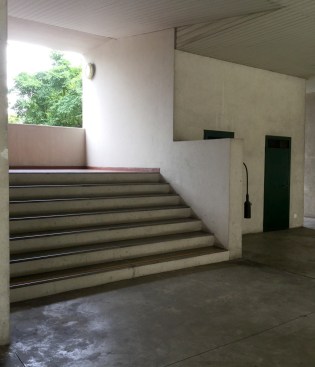
Aaron Betsky
When I first saw the Gallaratese housing project, it seemed both wrong and seductive. Part of that double feeling of appeal and repulsion comes from the quality it has that it is a dream of a building, with parts exaggerated and in the wrong place, but also more powerful than any real structure. Part of it also comes from the echoes of architecture commissioned by the Fascists in Italy, in particular the work of Giuseppe Terragni. At the same time, the building evokes Milan’s urban vernacular, an aspect Rossi saw as being at the core of his work. None of that completely explains the beauty of a building that should not work, that does so many things wrong, and yet still takes your breath away.
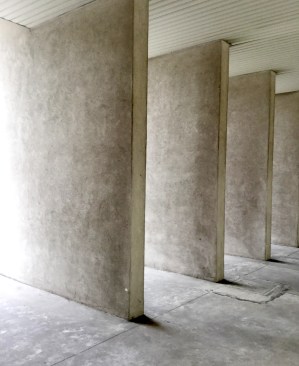
Aaron Betsky
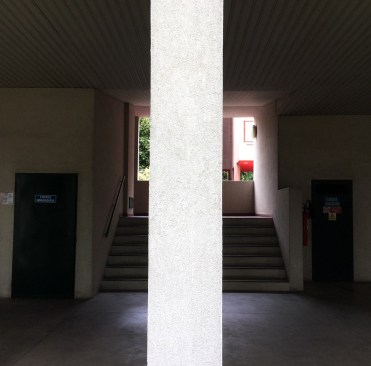
Aaron Betsky
Could it be that I just let myself be entranced by Scully’s lectures and Rossi’s drawings and writings, and thus am finding importance in a messed-up piece of architecture? In that case, I can only say the power of architecture inheres not just in the building, but in that architecture, which is to say the drawings and words through which it appeared and we can still understand it, as well as the subjective experience that makes those dead bones dance. This skeleton is, in my opinion, quite a dancer, even if its performance has an elegiac and even disturbing cadence.
Don’t get me wrong. While we were visiting, people went in and out of the building, carrying children and leaving their strollers in the gallery, while a lonely kid kicked a ball around, waiting for his friends to show up. Music drifted down from one of the apartments and a workman fidgeted with a pipe. There is life in this building. The structure just manages to house and frame that existence in something much stranger and grander, something that makes it into an even greater piece of architecture than what I saw in those slides 50 years ago.
